


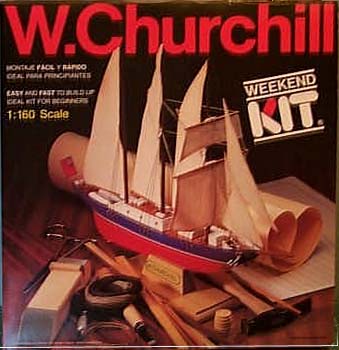 Training
Ship Sir Winston Churchill
Training
Ship Sir Winston Churchill
Artesania Latina 1/160 Schooner
Beatties, Kingston upon Thames price : £25.99
by Lynn Dunn
The Ship
Following the initial success of the Cutty Sark Tall Ships Race, the UK's Sail Training Association built a 3-masted top-sail schooner, the Sir Winston Churchill, in 1966. Having a permanent crew of five (a master, chief officer, bosun, engineer and cook) and a volunteer crew of navigator, purser, three watch officers and three watch leaders, she takes 39 trainees organised into three watches on up to 36 cruises a year covering some 30,000 miles. Having a length of 45.32 m, beam of 7.62m and a draught of 4.43m, she displaces almost 220 tons. Her success lead to a sister ship, the Malcolm Miller, being built in 1968.
Differing only in small internal detailing and square-shaped top deckhouse doors, these two schooners are very competitive against each other, helped by one being crewed by ladies, the other by men. The Sir Winston Churchill took Class B1 honours in the Tall Ships Race in her first year, as did the Malcolm Miller on her debut Tall Ships Race. They continue to enthrall the crowds wherever they port.
The Kit
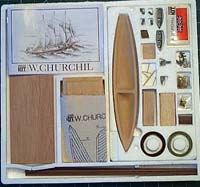
|
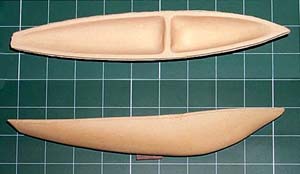
|
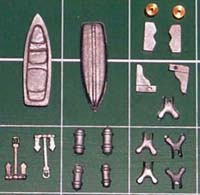
|
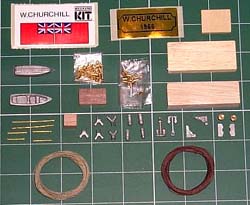
|
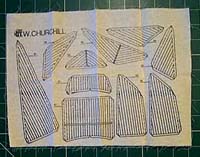
|
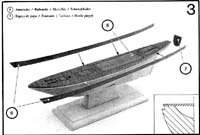
|
 |
On unsealing and opening the box, you get two multi-lingual instruction books, two extra sheets (in Portuguese), a sheet of canvas, and two interior boxes (one of which is sealed).
The first open box holds the instructions, as well as the die-cut parts to be added to the main hull. These are thin, but good quality plywood that hasn't warped. The cutting is well-done, and will require only the usual tidying up. Parts here include the deck, the bulwarks and the rudder. Moving to the masts, there are five dowels in two sizes (three 4mm and two 3mm), and are all walnut. These, when cut to size, make up the three masts, the bowsprit and various booms. The plinth is also here, and is Samba. The last part in this box is the canvas. This unfolds to reveal all the sails pre-printed. These require to be cut, trimmed, and hemmed before use, and are clearly numbered to the side of each sail.
The second sealed box contains all the small parts, of which there are many. Starting with the hull, which is made from prefabricated Art Wood, this is banana-shaped and just requires a small amount of tidying up. On our example, there is a small crack across the starboard side; this can be easily filled, and will be mostly hidden by the deck and bulwarks. Two small rolls of cotton are here, both rolls (one brown and one light green) being stiffened to help the rigging hold shape. The rear flag and the stand's nameplate (in a brass effect finish) are just paper stickers; nothing special. The wooden parts held in this box include the stand's hull mounting and the aft castle parts (again Samba), as well as the amidships skylight and forward deckhouse (in Walnut). The remaining parts are small metal pieces; there are two white metal lifeboats, windlass and anchors, brass port holes, eye bolts and sail rings. In total, there are 76 distinct parts with 134 pieces making up this schooner.
The quality of the cast brass parts is good, and while the brass rods were slightly bent they were easily straightened. The white metal parts are acceptable - even the poorest are good, while items such as the anchors are nicely defined. I would have preferred the white metal parts to be in brass, but as they will be painted anyway, this has no detrimental effect on the appearance of the finished model.
Looking at the two instruction books, they are made up as one multi-lingual text instruction book and one multi-lingual photo and diagram-based book. The instructions clearly inform you as to what extra materials and tools are required (nothing the average modeller won't have built up in his/her toolkit). The next few pages break the assembly into four main parts: hull, superstructure, masting and rigging, and are all easy to follow. The second booklet gives a basic history of the vessel, a 4-page detailed parts list, and 13 pages of clearly-numbered photos and 5 pages of clear diagrams. Having the parts numbered on the photos and diagrams makes life a lot easier, as you can quickly double-check what it is you have to get next. This is a good step-by-step guide, especially for the rigging, shrouds and sails. What could have been a nightmare will be quite easy, if not a dream to do.
The manufacturers reckon that this is a beginners weekend kit. I would agree, with the proviso that this is all you would be doing. A more realistic time scale would be two to three weekends, broken down into hull assembly & painting of the hull and small parts, preparing the sails, superstructure assembly and the rigging.
There are a couple of small problems with this kit. The schooner should have a fore staysail, a jib, an outer jib and a flying jib - the model is missing the outer jib. This could be added if you have spare canvas, but to be fair she has been known to sail with only three fore sails; the kit designer may only have had imagery of her in this rig. The box cover shows her with all provided sails out; you may want to get a photo of her underway, and rig her accordingly. You may also want to mark the aft sail with her ID pennant. The shroud locations should be handled with care, as should the anchor locations, as there are no hull marks to assist. On the painting front, the cover model shows a red underhull, and a royal blue upper hull with a white floatation line; this is inaccurate, as she has a black upper hull with no floatation line. I would suggest trying to obtain a replacement Red Ensign, as well as an STA top pennant for that final touch.
Conclusion
Overall this is a not a bad kit. With a couple of reference photos, this can be a very good example of a top-sail schooner, and can very easily be converted from the Churchill into the Malcolm Miller. Indeed, for any STA trainees, a pair of these (as Churchill and Miller) would be magnificent. This kit is well-worth paying the full price for, and I look forward to building her and some of the more advanced models in the series.

Previous: Contents








